Business Negotiations: Part A Report - Case Study Analysis
VerifiedAdded on 2022/08/09
|8
|3597
|23
Report
AI Summary
This report provides a comprehensive analysis of business negotiations, particularly focusing on the challenges and strategies involved in cross-cultural contexts, specifically between American and Chinese entities. The report delves into the importance of trust, exploring how cultural differences in work ethics, individualism versus collectivism, and communication styles can impact negotiation outcomes. It examines ethical reasoning differences between American and Chinese cultures, highlighting the significance of understanding cultural norms and social contracts. Furthermore, the report emphasizes the crucial role of communication in building relationships and resolving conflicts in multi-partite negotiations, addressing potential conflict situations and recommending communication strategies. It also discusses various hardball tactics used in distributive bargaining, such as the bogey and aggressive behavior, providing a comprehensive understanding of negotiation dynamics.
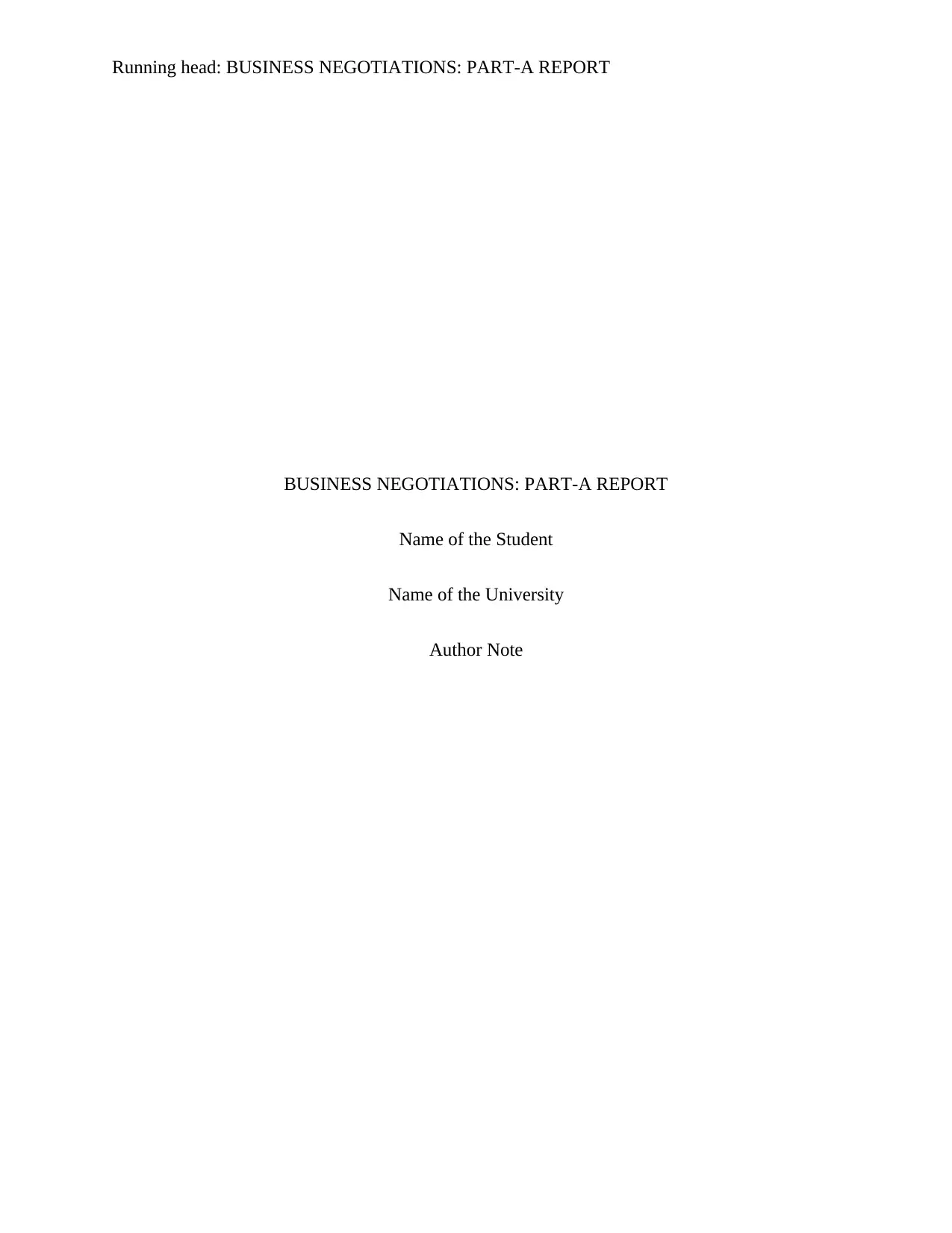
Running head: BUSINESS NEGOTIATIONS: PART-A REPORT
BUSINESS NEGOTIATIONS: PART-A REPORT
Name of the Student
Name of the University
Author Note
BUSINESS NEGOTIATIONS: PART-A REPORT
Name of the Student
Name of the University
Author Note
Paraphrase This Document
Need a fresh take? Get an instant paraphrase of this document with our AI Paraphraser
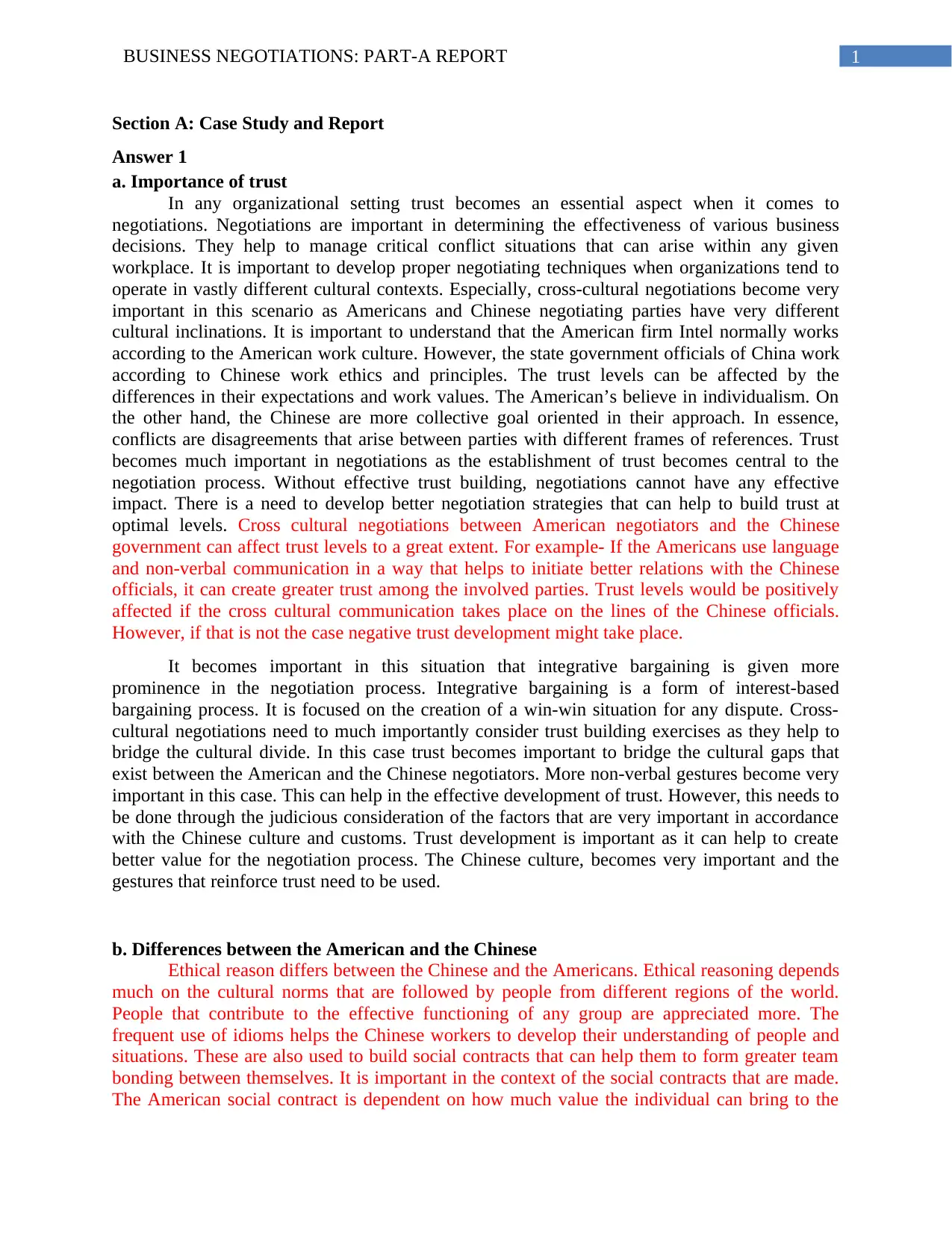
1BUSINESS NEGOTIATIONS: PART-A REPORT
Section A: Case Study and Report
Answer 1
a. Importance of trust
In any organizational setting trust becomes an essential aspect when it comes to
negotiations. Negotiations are important in determining the effectiveness of various business
decisions. They help to manage critical conflict situations that can arise within any given
workplace. It is important to develop proper negotiating techniques when organizations tend to
operate in vastly different cultural contexts. Especially, cross-cultural negotiations become very
important in this scenario as Americans and Chinese negotiating parties have very different
cultural inclinations. It is important to understand that the American firm Intel normally works
according to the American work culture. However, the state government officials of China work
according to Chinese work ethics and principles. The trust levels can be affected by the
differences in their expectations and work values. The American’s believe in individualism. On
the other hand, the Chinese are more collective goal oriented in their approach. In essence,
conflicts are disagreements that arise between parties with different frames of references. Trust
becomes much important in negotiations as the establishment of trust becomes central to the
negotiation process. Without effective trust building, negotiations cannot have any effective
impact. There is a need to develop better negotiation strategies that can help to build trust at
optimal levels. Cross cultural negotiations between American negotiators and the Chinese
government can affect trust levels to a great extent. For example- If the Americans use language
and non-verbal communication in a way that helps to initiate better relations with the Chinese
officials, it can create greater trust among the involved parties. Trust levels would be positively
affected if the cross cultural communication takes place on the lines of the Chinese officials.
However, if that is not the case negative trust development might take place.
It becomes important in this situation that integrative bargaining is given more
prominence in the negotiation process. Integrative bargaining is a form of interest-based
bargaining process. It is focused on the creation of a win-win situation for any dispute. Cross-
cultural negotiations need to much importantly consider trust building exercises as they help to
bridge the cultural divide. In this case trust becomes important to bridge the cultural gaps that
exist between the American and the Chinese negotiators. More non-verbal gestures become very
important in this case. This can help in the effective development of trust. However, this needs to
be done through the judicious consideration of the factors that are very important in accordance
with the Chinese culture and customs. Trust development is important as it can help to create
better value for the negotiation process. The Chinese culture, becomes very important and the
gestures that reinforce trust need to be used.
b. Differences between the American and the Chinese
Ethical reason differs between the Chinese and the Americans. Ethical reasoning depends
much on the cultural norms that are followed by people from different regions of the world.
People that contribute to the effective functioning of any group are appreciated more. The
frequent use of idioms helps the Chinese workers to develop their understanding of people and
situations. These are also used to build social contracts that can help them to form greater team
bonding between themselves. It is important in the context of the social contracts that are made.
The American social contract is dependent on how much value the individual can bring to the
Section A: Case Study and Report
Answer 1
a. Importance of trust
In any organizational setting trust becomes an essential aspect when it comes to
negotiations. Negotiations are important in determining the effectiveness of various business
decisions. They help to manage critical conflict situations that can arise within any given
workplace. It is important to develop proper negotiating techniques when organizations tend to
operate in vastly different cultural contexts. Especially, cross-cultural negotiations become very
important in this scenario as Americans and Chinese negotiating parties have very different
cultural inclinations. It is important to understand that the American firm Intel normally works
according to the American work culture. However, the state government officials of China work
according to Chinese work ethics and principles. The trust levels can be affected by the
differences in their expectations and work values. The American’s believe in individualism. On
the other hand, the Chinese are more collective goal oriented in their approach. In essence,
conflicts are disagreements that arise between parties with different frames of references. Trust
becomes much important in negotiations as the establishment of trust becomes central to the
negotiation process. Without effective trust building, negotiations cannot have any effective
impact. There is a need to develop better negotiation strategies that can help to build trust at
optimal levels. Cross cultural negotiations between American negotiators and the Chinese
government can affect trust levels to a great extent. For example- If the Americans use language
and non-verbal communication in a way that helps to initiate better relations with the Chinese
officials, it can create greater trust among the involved parties. Trust levels would be positively
affected if the cross cultural communication takes place on the lines of the Chinese officials.
However, if that is not the case negative trust development might take place.
It becomes important in this situation that integrative bargaining is given more
prominence in the negotiation process. Integrative bargaining is a form of interest-based
bargaining process. It is focused on the creation of a win-win situation for any dispute. Cross-
cultural negotiations need to much importantly consider trust building exercises as they help to
bridge the cultural divide. In this case trust becomes important to bridge the cultural gaps that
exist between the American and the Chinese negotiators. More non-verbal gestures become very
important in this case. This can help in the effective development of trust. However, this needs to
be done through the judicious consideration of the factors that are very important in accordance
with the Chinese culture and customs. Trust development is important as it can help to create
better value for the negotiation process. The Chinese culture, becomes very important and the
gestures that reinforce trust need to be used.
b. Differences between the American and the Chinese
Ethical reason differs between the Chinese and the Americans. Ethical reasoning depends
much on the cultural norms that are followed by people from different regions of the world.
People that contribute to the effective functioning of any group are appreciated more. The
frequent use of idioms helps the Chinese workers to develop their understanding of people and
situations. These are also used to build social contracts that can help them to form greater team
bonding between themselves. It is important in the context of the social contracts that are made.
The American social contract is dependent on how much value the individual can bring to the
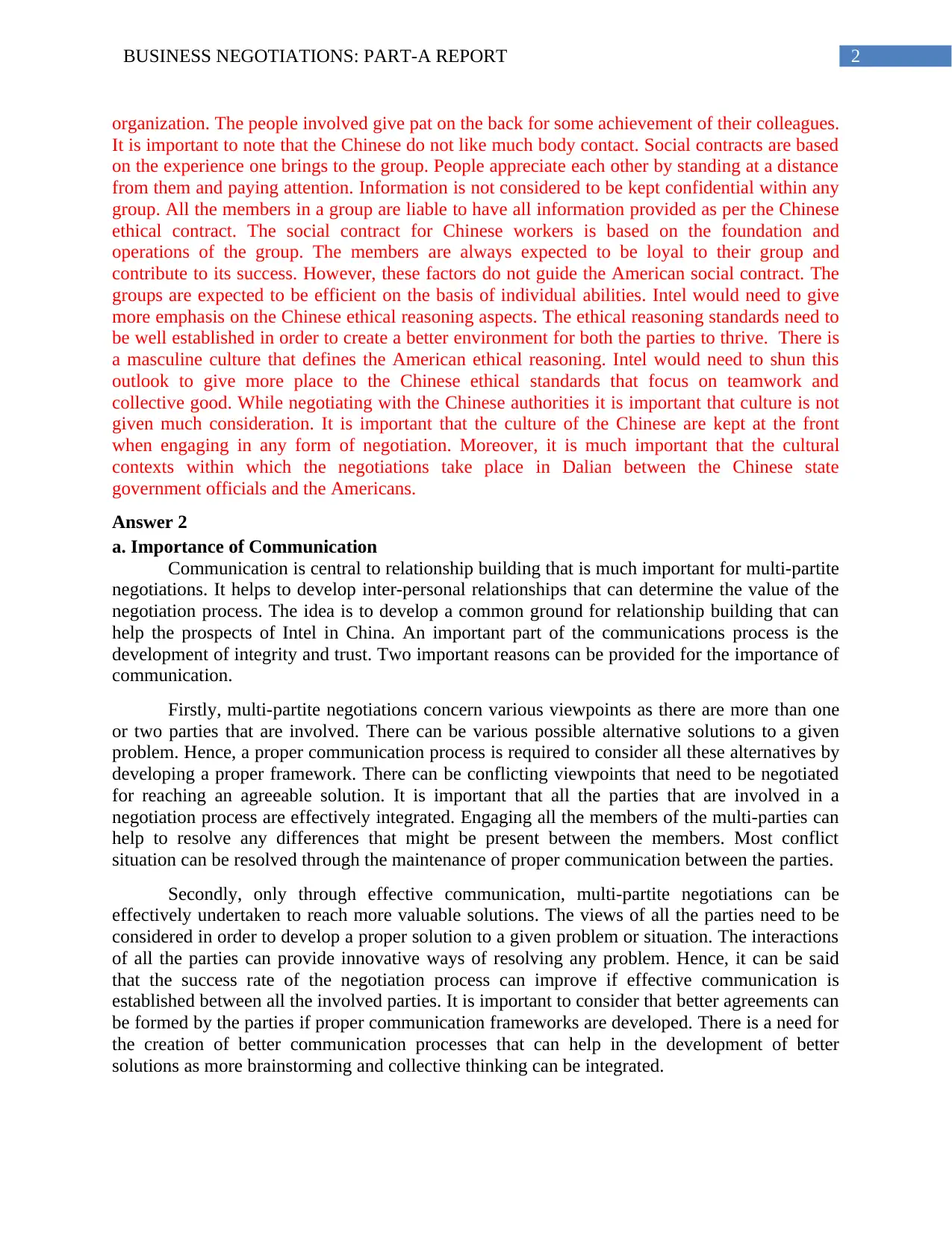
2BUSINESS NEGOTIATIONS: PART-A REPORT
organization. The people involved give pat on the back for some achievement of their colleagues.
It is important to note that the Chinese do not like much body contact. Social contracts are based
on the experience one brings to the group. People appreciate each other by standing at a distance
from them and paying attention. Information is not considered to be kept confidential within any
group. All the members in a group are liable to have all information provided as per the Chinese
ethical contract. The social contract for Chinese workers is based on the foundation and
operations of the group. The members are always expected to be loyal to their group and
contribute to its success. However, these factors do not guide the American social contract. The
groups are expected to be efficient on the basis of individual abilities. Intel would need to give
more emphasis on the Chinese ethical reasoning aspects. The ethical reasoning standards need to
be well established in order to create a better environment for both the parties to thrive. There is
a masculine culture that defines the American ethical reasoning. Intel would need to shun this
outlook to give more place to the Chinese ethical standards that focus on teamwork and
collective good. While negotiating with the Chinese authorities it is important that culture is not
given much consideration. It is important that the culture of the Chinese are kept at the front
when engaging in any form of negotiation. Moreover, it is much important that the cultural
contexts within which the negotiations take place in Dalian between the Chinese state
government officials and the Americans.
Answer 2
a. Importance of Communication
Communication is central to relationship building that is much important for multi-partite
negotiations. It helps to develop inter-personal relationships that can determine the value of the
negotiation process. The idea is to develop a common ground for relationship building that can
help the prospects of Intel in China. An important part of the communications process is the
development of integrity and trust. Two important reasons can be provided for the importance of
communication.
Firstly, multi-partite negotiations concern various viewpoints as there are more than one
or two parties that are involved. There can be various possible alternative solutions to a given
problem. Hence, a proper communication process is required to consider all these alternatives by
developing a proper framework. There can be conflicting viewpoints that need to be negotiated
for reaching an agreeable solution. It is important that all the parties that are involved in a
negotiation process are effectively integrated. Engaging all the members of the multi-parties can
help to resolve any differences that might be present between the members. Most conflict
situation can be resolved through the maintenance of proper communication between the parties.
Secondly, only through effective communication, multi-partite negotiations can be
effectively undertaken to reach more valuable solutions. The views of all the parties need to be
considered in order to develop a proper solution to a given problem or situation. The interactions
of all the parties can provide innovative ways of resolving any problem. Hence, it can be said
that the success rate of the negotiation process can improve if effective communication is
established between all the involved parties. It is important to consider that better agreements can
be formed by the parties if proper communication frameworks are developed. There is a need for
the creation of better communication processes that can help in the development of better
solutions as more brainstorming and collective thinking can be integrated.
organization. The people involved give pat on the back for some achievement of their colleagues.
It is important to note that the Chinese do not like much body contact. Social contracts are based
on the experience one brings to the group. People appreciate each other by standing at a distance
from them and paying attention. Information is not considered to be kept confidential within any
group. All the members in a group are liable to have all information provided as per the Chinese
ethical contract. The social contract for Chinese workers is based on the foundation and
operations of the group. The members are always expected to be loyal to their group and
contribute to its success. However, these factors do not guide the American social contract. The
groups are expected to be efficient on the basis of individual abilities. Intel would need to give
more emphasis on the Chinese ethical reasoning aspects. The ethical reasoning standards need to
be well established in order to create a better environment for both the parties to thrive. There is
a masculine culture that defines the American ethical reasoning. Intel would need to shun this
outlook to give more place to the Chinese ethical standards that focus on teamwork and
collective good. While negotiating with the Chinese authorities it is important that culture is not
given much consideration. It is important that the culture of the Chinese are kept at the front
when engaging in any form of negotiation. Moreover, it is much important that the cultural
contexts within which the negotiations take place in Dalian between the Chinese state
government officials and the Americans.
Answer 2
a. Importance of Communication
Communication is central to relationship building that is much important for multi-partite
negotiations. It helps to develop inter-personal relationships that can determine the value of the
negotiation process. The idea is to develop a common ground for relationship building that can
help the prospects of Intel in China. An important part of the communications process is the
development of integrity and trust. Two important reasons can be provided for the importance of
communication.
Firstly, multi-partite negotiations concern various viewpoints as there are more than one
or two parties that are involved. There can be various possible alternative solutions to a given
problem. Hence, a proper communication process is required to consider all these alternatives by
developing a proper framework. There can be conflicting viewpoints that need to be negotiated
for reaching an agreeable solution. It is important that all the parties that are involved in a
negotiation process are effectively integrated. Engaging all the members of the multi-parties can
help to resolve any differences that might be present between the members. Most conflict
situation can be resolved through the maintenance of proper communication between the parties.
Secondly, only through effective communication, multi-partite negotiations can be
effectively undertaken to reach more valuable solutions. The views of all the parties need to be
considered in order to develop a proper solution to a given problem or situation. The interactions
of all the parties can provide innovative ways of resolving any problem. Hence, it can be said
that the success rate of the negotiation process can improve if effective communication is
established between all the involved parties. It is important to consider that better agreements can
be formed by the parties if proper communication frameworks are developed. There is a need for
the creation of better communication processes that can help in the development of better
solutions as more brainstorming and collective thinking can be integrated.
⊘ This is a preview!⊘
Do you want full access?
Subscribe today to unlock all pages.

Trusted by 1+ million students worldwide
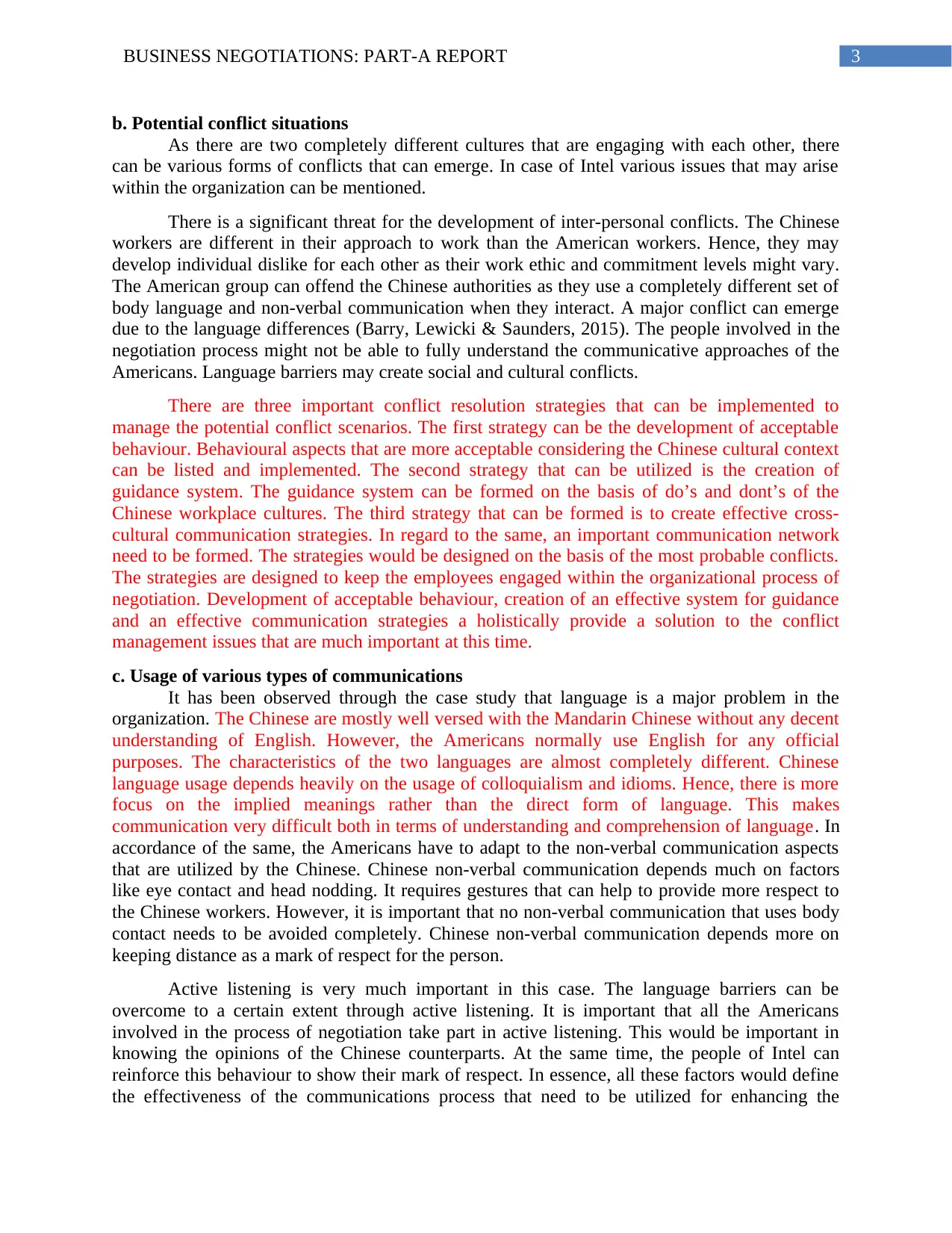
3BUSINESS NEGOTIATIONS: PART-A REPORT
b. Potential conflict situations
As there are two completely different cultures that are engaging with each other, there
can be various forms of conflicts that can emerge. In case of Intel various issues that may arise
within the organization can be mentioned.
There is a significant threat for the development of inter-personal conflicts. The Chinese
workers are different in their approach to work than the American workers. Hence, they may
develop individual dislike for each other as their work ethic and commitment levels might vary.
The American group can offend the Chinese authorities as they use a completely different set of
body language and non-verbal communication when they interact. A major conflict can emerge
due to the language differences (Barry, Lewicki & Saunders, 2015). The people involved in the
negotiation process might not be able to fully understand the communicative approaches of the
Americans. Language barriers may create social and cultural conflicts.
There are three important conflict resolution strategies that can be implemented to
manage the potential conflict scenarios. The first strategy can be the development of acceptable
behaviour. Behavioural aspects that are more acceptable considering the Chinese cultural context
can be listed and implemented. The second strategy that can be utilized is the creation of
guidance system. The guidance system can be formed on the basis of do’s and dont’s of the
Chinese workplace cultures. The third strategy that can be formed is to create effective cross-
cultural communication strategies. In regard to the same, an important communication network
need to be formed. The strategies would be designed on the basis of the most probable conflicts.
The strategies are designed to keep the employees engaged within the organizational process of
negotiation. Development of acceptable behaviour, creation of an effective system for guidance
and an effective communication strategies a holistically provide a solution to the conflict
management issues that are much important at this time.
c. Usage of various types of communications
It has been observed through the case study that language is a major problem in the
organization. The Chinese are mostly well versed with the Mandarin Chinese without any decent
understanding of English. However, the Americans normally use English for any official
purposes. The characteristics of the two languages are almost completely different. Chinese
language usage depends heavily on the usage of colloquialism and idioms. Hence, there is more
focus on the implied meanings rather than the direct form of language. This makes
communication very difficult both in terms of understanding and comprehension of language. In
accordance of the same, the Americans have to adapt to the non-verbal communication aspects
that are utilized by the Chinese. Chinese non-verbal communication depends much on factors
like eye contact and head nodding. It requires gestures that can help to provide more respect to
the Chinese workers. However, it is important that no non-verbal communication that uses body
contact needs to be avoided completely. Chinese non-verbal communication depends more on
keeping distance as a mark of respect for the person.
Active listening is very much important in this case. The language barriers can be
overcome to a certain extent through active listening. It is important that all the Americans
involved in the process of negotiation take part in active listening. This would be important in
knowing the opinions of the Chinese counterparts. At the same time, the people of Intel can
reinforce this behaviour to show their mark of respect. In essence, all these factors would define
the effectiveness of the communications process that need to be utilized for enhancing the
b. Potential conflict situations
As there are two completely different cultures that are engaging with each other, there
can be various forms of conflicts that can emerge. In case of Intel various issues that may arise
within the organization can be mentioned.
There is a significant threat for the development of inter-personal conflicts. The Chinese
workers are different in their approach to work than the American workers. Hence, they may
develop individual dislike for each other as their work ethic and commitment levels might vary.
The American group can offend the Chinese authorities as they use a completely different set of
body language and non-verbal communication when they interact. A major conflict can emerge
due to the language differences (Barry, Lewicki & Saunders, 2015). The people involved in the
negotiation process might not be able to fully understand the communicative approaches of the
Americans. Language barriers may create social and cultural conflicts.
There are three important conflict resolution strategies that can be implemented to
manage the potential conflict scenarios. The first strategy can be the development of acceptable
behaviour. Behavioural aspects that are more acceptable considering the Chinese cultural context
can be listed and implemented. The second strategy that can be utilized is the creation of
guidance system. The guidance system can be formed on the basis of do’s and dont’s of the
Chinese workplace cultures. The third strategy that can be formed is to create effective cross-
cultural communication strategies. In regard to the same, an important communication network
need to be formed. The strategies would be designed on the basis of the most probable conflicts.
The strategies are designed to keep the employees engaged within the organizational process of
negotiation. Development of acceptable behaviour, creation of an effective system for guidance
and an effective communication strategies a holistically provide a solution to the conflict
management issues that are much important at this time.
c. Usage of various types of communications
It has been observed through the case study that language is a major problem in the
organization. The Chinese are mostly well versed with the Mandarin Chinese without any decent
understanding of English. However, the Americans normally use English for any official
purposes. The characteristics of the two languages are almost completely different. Chinese
language usage depends heavily on the usage of colloquialism and idioms. Hence, there is more
focus on the implied meanings rather than the direct form of language. This makes
communication very difficult both in terms of understanding and comprehension of language. In
accordance of the same, the Americans have to adapt to the non-verbal communication aspects
that are utilized by the Chinese. Chinese non-verbal communication depends much on factors
like eye contact and head nodding. It requires gestures that can help to provide more respect to
the Chinese workers. However, it is important that no non-verbal communication that uses body
contact needs to be avoided completely. Chinese non-verbal communication depends more on
keeping distance as a mark of respect for the person.
Active listening is very much important in this case. The language barriers can be
overcome to a certain extent through active listening. It is important that all the Americans
involved in the process of negotiation take part in active listening. This would be important in
knowing the opinions of the Chinese counterparts. At the same time, the people of Intel can
reinforce this behaviour to show their mark of respect. In essence, all these factors would define
the effectiveness of the communications process that need to be utilized for enhancing the
Paraphrase This Document
Need a fresh take? Get an instant paraphrase of this document with our AI Paraphraser
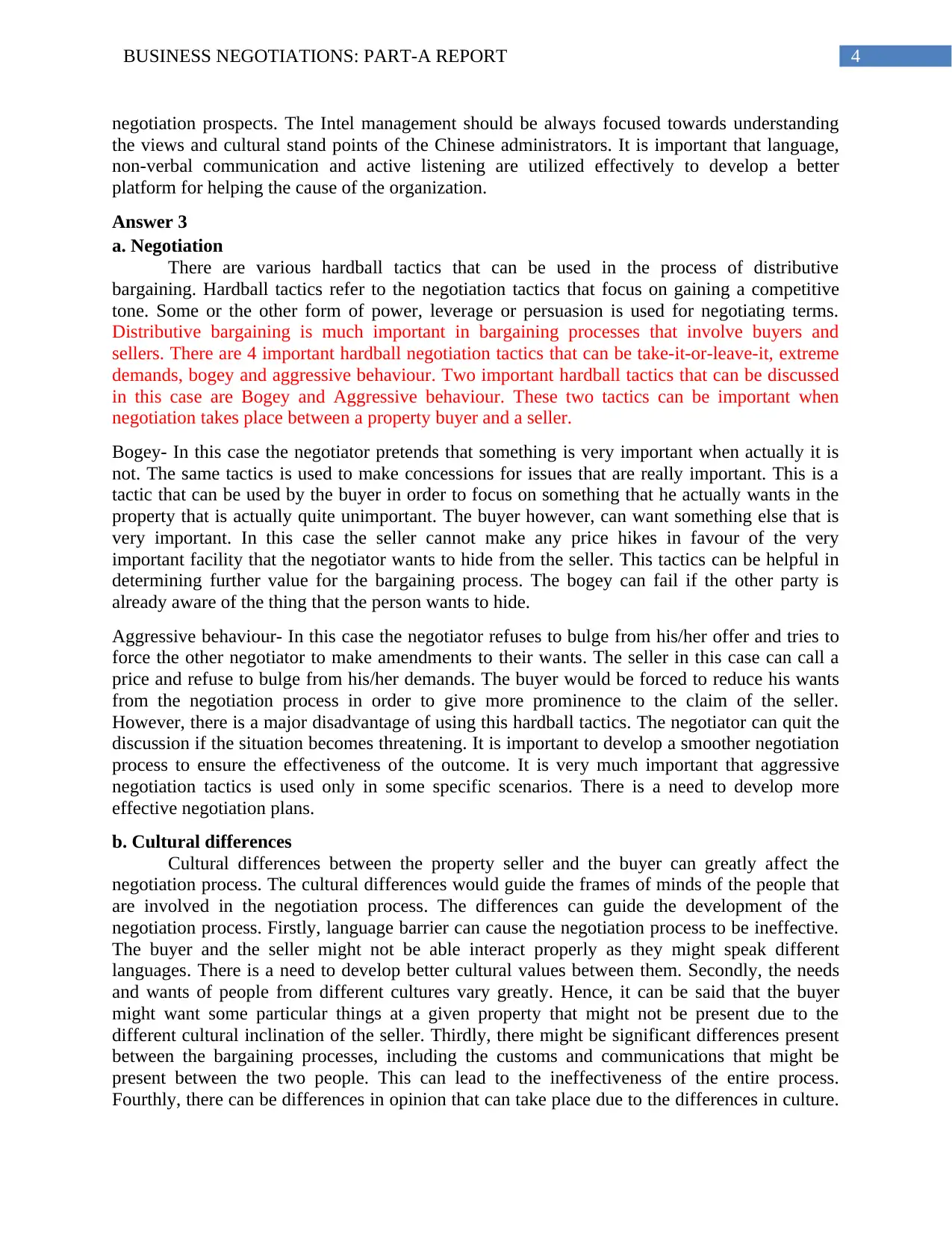
4BUSINESS NEGOTIATIONS: PART-A REPORT
negotiation prospects. The Intel management should be always focused towards understanding
the views and cultural stand points of the Chinese administrators. It is important that language,
non-verbal communication and active listening are utilized effectively to develop a better
platform for helping the cause of the organization.
Answer 3
a. Negotiation
There are various hardball tactics that can be used in the process of distributive
bargaining. Hardball tactics refer to the negotiation tactics that focus on gaining a competitive
tone. Some or the other form of power, leverage or persuasion is used for negotiating terms.
Distributive bargaining is much important in bargaining processes that involve buyers and
sellers. There are 4 important hardball negotiation tactics that can be take-it-or-leave-it, extreme
demands, bogey and aggressive behaviour. Two important hardball tactics that can be discussed
in this case are Bogey and Aggressive behaviour. These two tactics can be important when
negotiation takes place between a property buyer and a seller.
Bogey- In this case the negotiator pretends that something is very important when actually it is
not. The same tactics is used to make concessions for issues that are really important. This is a
tactic that can be used by the buyer in order to focus on something that he actually wants in the
property that is actually quite unimportant. The buyer however, can want something else that is
very important. In this case the seller cannot make any price hikes in favour of the very
important facility that the negotiator wants to hide from the seller. This tactics can be helpful in
determining further value for the bargaining process. The bogey can fail if the other party is
already aware of the thing that the person wants to hide.
Aggressive behaviour- In this case the negotiator refuses to bulge from his/her offer and tries to
force the other negotiator to make amendments to their wants. The seller in this case can call a
price and refuse to bulge from his/her demands. The buyer would be forced to reduce his wants
from the negotiation process in order to give more prominence to the claim of the seller.
However, there is a major disadvantage of using this hardball tactics. The negotiator can quit the
discussion if the situation becomes threatening. It is important to develop a smoother negotiation
process to ensure the effectiveness of the outcome. It is very much important that aggressive
negotiation tactics is used only in some specific scenarios. There is a need to develop more
effective negotiation plans.
b. Cultural differences
Cultural differences between the property seller and the buyer can greatly affect the
negotiation process. The cultural differences would guide the frames of minds of the people that
are involved in the negotiation process. The differences can guide the development of the
negotiation process. Firstly, language barrier can cause the negotiation process to be ineffective.
The buyer and the seller might not be able interact properly as they might speak different
languages. There is a need to develop better cultural values between them. Secondly, the needs
and wants of people from different cultures vary greatly. Hence, it can be said that the buyer
might want some particular things at a given property that might not be present due to the
different cultural inclination of the seller. Thirdly, there might be significant differences present
between the bargaining processes, including the customs and communications that might be
present between the two people. This can lead to the ineffectiveness of the entire process.
Fourthly, there can be differences in opinion that can take place due to the differences in culture.
negotiation prospects. The Intel management should be always focused towards understanding
the views and cultural stand points of the Chinese administrators. It is important that language,
non-verbal communication and active listening are utilized effectively to develop a better
platform for helping the cause of the organization.
Answer 3
a. Negotiation
There are various hardball tactics that can be used in the process of distributive
bargaining. Hardball tactics refer to the negotiation tactics that focus on gaining a competitive
tone. Some or the other form of power, leverage or persuasion is used for negotiating terms.
Distributive bargaining is much important in bargaining processes that involve buyers and
sellers. There are 4 important hardball negotiation tactics that can be take-it-or-leave-it, extreme
demands, bogey and aggressive behaviour. Two important hardball tactics that can be discussed
in this case are Bogey and Aggressive behaviour. These two tactics can be important when
negotiation takes place between a property buyer and a seller.
Bogey- In this case the negotiator pretends that something is very important when actually it is
not. The same tactics is used to make concessions for issues that are really important. This is a
tactic that can be used by the buyer in order to focus on something that he actually wants in the
property that is actually quite unimportant. The buyer however, can want something else that is
very important. In this case the seller cannot make any price hikes in favour of the very
important facility that the negotiator wants to hide from the seller. This tactics can be helpful in
determining further value for the bargaining process. The bogey can fail if the other party is
already aware of the thing that the person wants to hide.
Aggressive behaviour- In this case the negotiator refuses to bulge from his/her offer and tries to
force the other negotiator to make amendments to their wants. The seller in this case can call a
price and refuse to bulge from his/her demands. The buyer would be forced to reduce his wants
from the negotiation process in order to give more prominence to the claim of the seller.
However, there is a major disadvantage of using this hardball tactics. The negotiator can quit the
discussion if the situation becomes threatening. It is important to develop a smoother negotiation
process to ensure the effectiveness of the outcome. It is very much important that aggressive
negotiation tactics is used only in some specific scenarios. There is a need to develop more
effective negotiation plans.
b. Cultural differences
Cultural differences between the property seller and the buyer can greatly affect the
negotiation process. The cultural differences would guide the frames of minds of the people that
are involved in the negotiation process. The differences can guide the development of the
negotiation process. Firstly, language barrier can cause the negotiation process to be ineffective.
The buyer and the seller might not be able interact properly as they might speak different
languages. There is a need to develop better cultural values between them. Secondly, the needs
and wants of people from different cultures vary greatly. Hence, it can be said that the buyer
might want some particular things at a given property that might not be present due to the
different cultural inclination of the seller. Thirdly, there might be significant differences present
between the bargaining processes, including the customs and communications that might be
present between the two people. This can lead to the ineffectiveness of the entire process.
Fourthly, there can be differences in opinion that can take place due to the differences in culture.
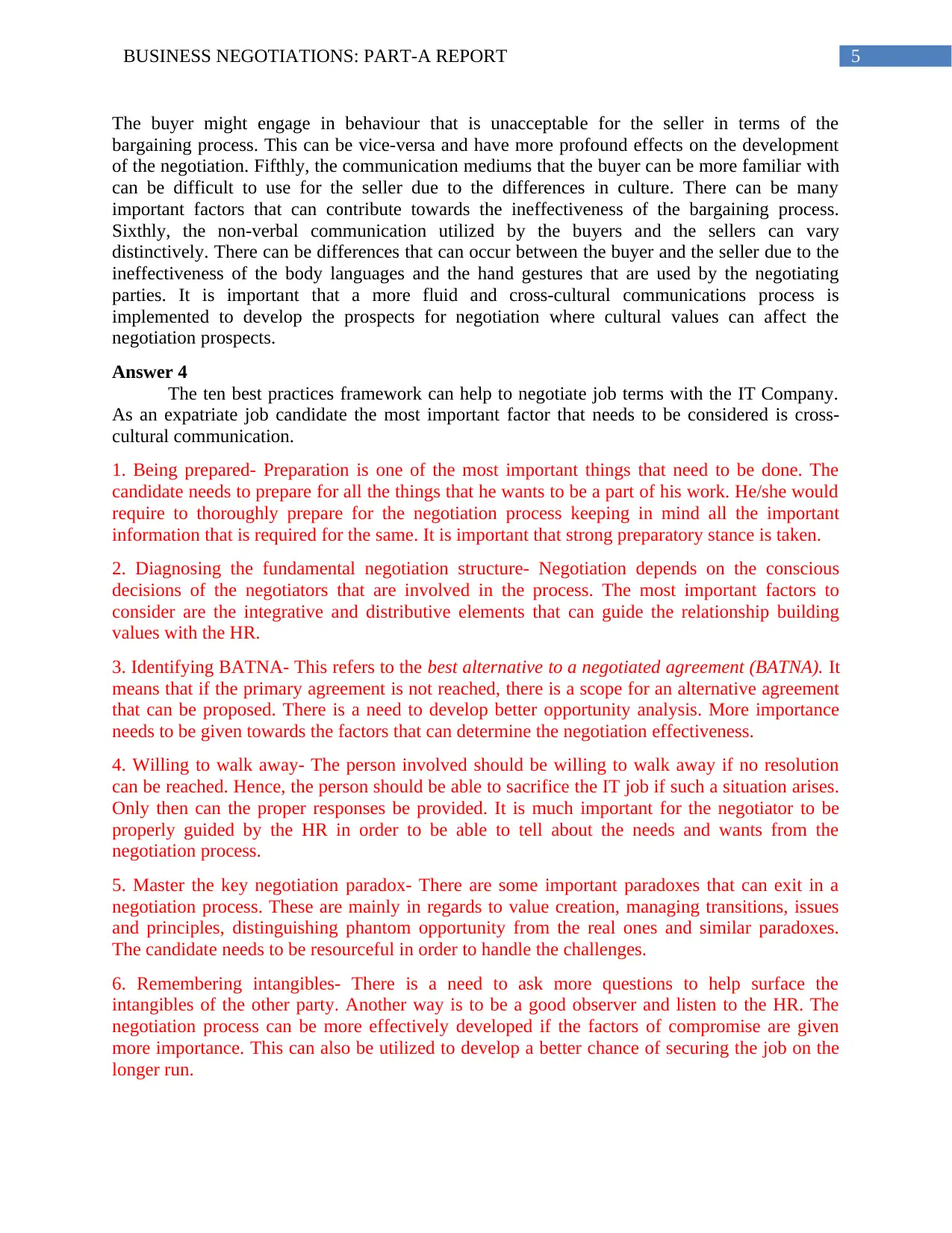
5BUSINESS NEGOTIATIONS: PART-A REPORT
The buyer might engage in behaviour that is unacceptable for the seller in terms of the
bargaining process. This can be vice-versa and have more profound effects on the development
of the negotiation. Fifthly, the communication mediums that the buyer can be more familiar with
can be difficult to use for the seller due to the differences in culture. There can be many
important factors that can contribute towards the ineffectiveness of the bargaining process.
Sixthly, the non-verbal communication utilized by the buyers and the sellers can vary
distinctively. There can be differences that can occur between the buyer and the seller due to the
ineffectiveness of the body languages and the hand gestures that are used by the negotiating
parties. It is important that a more fluid and cross-cultural communications process is
implemented to develop the prospects for negotiation where cultural values can affect the
negotiation prospects.
Answer 4
The ten best practices framework can help to negotiate job terms with the IT Company.
As an expatriate job candidate the most important factor that needs to be considered is cross-
cultural communication.
1. Being prepared- Preparation is one of the most important things that need to be done. The
candidate needs to prepare for all the things that he wants to be a part of his work. He/she would
require to thoroughly prepare for the negotiation process keeping in mind all the important
information that is required for the same. It is important that strong preparatory stance is taken.
2. Diagnosing the fundamental negotiation structure- Negotiation depends on the conscious
decisions of the negotiators that are involved in the process. The most important factors to
consider are the integrative and distributive elements that can guide the relationship building
values with the HR.
3. Identifying BATNA- This refers to the best alternative to a negotiated agreement (BATNA). It
means that if the primary agreement is not reached, there is a scope for an alternative agreement
that can be proposed. There is a need to develop better opportunity analysis. More importance
needs to be given towards the factors that can determine the negotiation effectiveness.
4. Willing to walk away- The person involved should be willing to walk away if no resolution
can be reached. Hence, the person should be able to sacrifice the IT job if such a situation arises.
Only then can the proper responses be provided. It is much important for the negotiator to be
properly guided by the HR in order to be able to tell about the needs and wants from the
negotiation process.
5. Master the key negotiation paradox- There are some important paradoxes that can exit in a
negotiation process. These are mainly in regards to value creation, managing transitions, issues
and principles, distinguishing phantom opportunity from the real ones and similar paradoxes.
The candidate needs to be resourceful in order to handle the challenges.
6. Remembering intangibles- There is a need to ask more questions to help surface the
intangibles of the other party. Another way is to be a good observer and listen to the HR. The
negotiation process can be more effectively developed if the factors of compromise are given
more importance. This can also be utilized to develop a better chance of securing the job on the
longer run.
The buyer might engage in behaviour that is unacceptable for the seller in terms of the
bargaining process. This can be vice-versa and have more profound effects on the development
of the negotiation. Fifthly, the communication mediums that the buyer can be more familiar with
can be difficult to use for the seller due to the differences in culture. There can be many
important factors that can contribute towards the ineffectiveness of the bargaining process.
Sixthly, the non-verbal communication utilized by the buyers and the sellers can vary
distinctively. There can be differences that can occur between the buyer and the seller due to the
ineffectiveness of the body languages and the hand gestures that are used by the negotiating
parties. It is important that a more fluid and cross-cultural communications process is
implemented to develop the prospects for negotiation where cultural values can affect the
negotiation prospects.
Answer 4
The ten best practices framework can help to negotiate job terms with the IT Company.
As an expatriate job candidate the most important factor that needs to be considered is cross-
cultural communication.
1. Being prepared- Preparation is one of the most important things that need to be done. The
candidate needs to prepare for all the things that he wants to be a part of his work. He/she would
require to thoroughly prepare for the negotiation process keeping in mind all the important
information that is required for the same. It is important that strong preparatory stance is taken.
2. Diagnosing the fundamental negotiation structure- Negotiation depends on the conscious
decisions of the negotiators that are involved in the process. The most important factors to
consider are the integrative and distributive elements that can guide the relationship building
values with the HR.
3. Identifying BATNA- This refers to the best alternative to a negotiated agreement (BATNA). It
means that if the primary agreement is not reached, there is a scope for an alternative agreement
that can be proposed. There is a need to develop better opportunity analysis. More importance
needs to be given towards the factors that can determine the negotiation effectiveness.
4. Willing to walk away- The person involved should be willing to walk away if no resolution
can be reached. Hence, the person should be able to sacrifice the IT job if such a situation arises.
Only then can the proper responses be provided. It is much important for the negotiator to be
properly guided by the HR in order to be able to tell about the needs and wants from the
negotiation process.
5. Master the key negotiation paradox- There are some important paradoxes that can exit in a
negotiation process. These are mainly in regards to value creation, managing transitions, issues
and principles, distinguishing phantom opportunity from the real ones and similar paradoxes.
The candidate needs to be resourceful in order to handle the challenges.
6. Remembering intangibles- There is a need to ask more questions to help surface the
intangibles of the other party. Another way is to be a good observer and listen to the HR. The
negotiation process can be more effectively developed if the factors of compromise are given
more importance. This can also be utilized to develop a better chance of securing the job on the
longer run.
⊘ This is a preview!⊘
Do you want full access?
Subscribe today to unlock all pages.

Trusted by 1+ million students worldwide
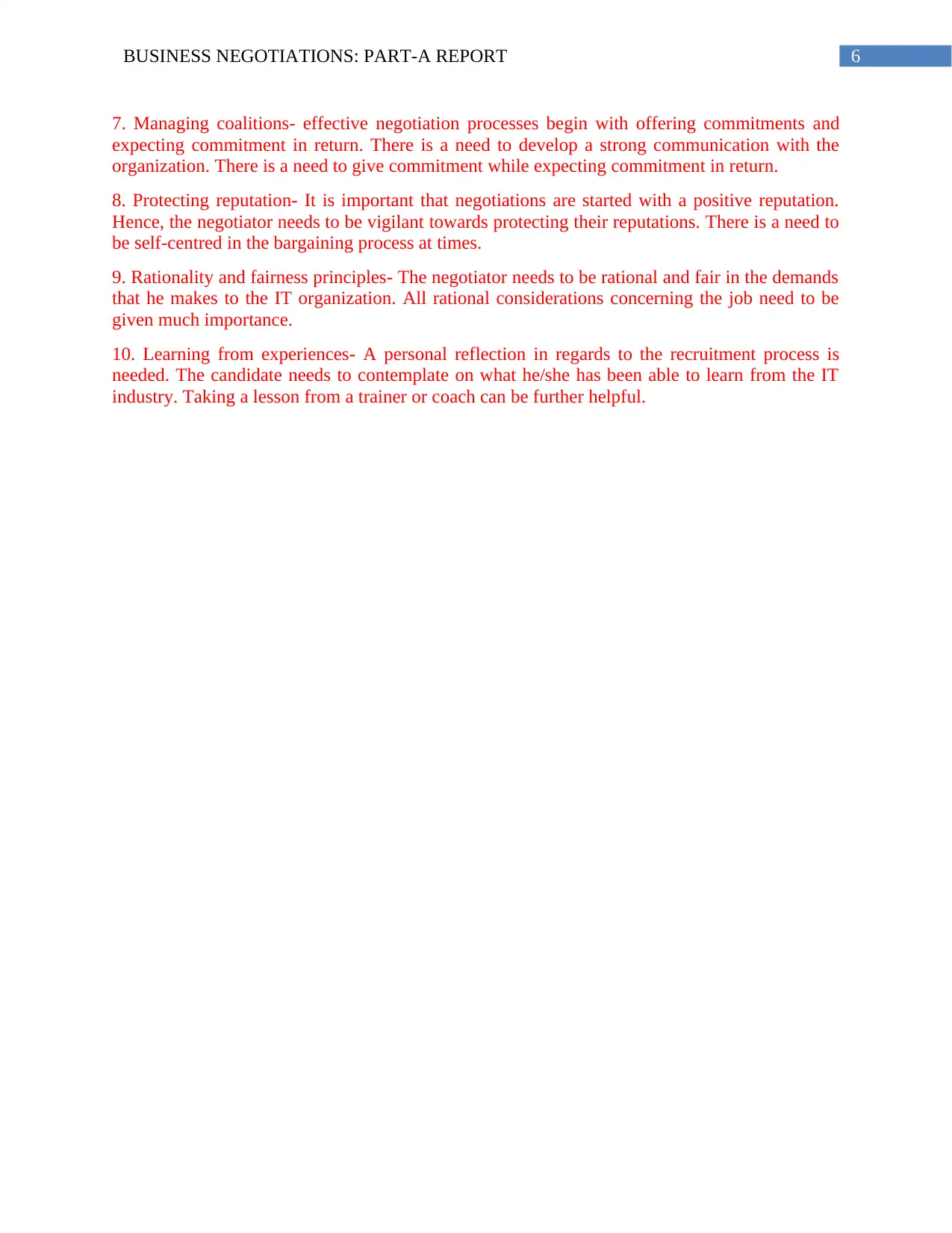
6BUSINESS NEGOTIATIONS: PART-A REPORT
7. Managing coalitions- effective negotiation processes begin with offering commitments and
expecting commitment in return. There is a need to develop a strong communication with the
organization. There is a need to give commitment while expecting commitment in return.
8. Protecting reputation- It is important that negotiations are started with a positive reputation.
Hence, the negotiator needs to be vigilant towards protecting their reputations. There is a need to
be self-centred in the bargaining process at times.
9. Rationality and fairness principles- The negotiator needs to be rational and fair in the demands
that he makes to the IT organization. All rational considerations concerning the job need to be
given much importance.
10. Learning from experiences- A personal reflection in regards to the recruitment process is
needed. The candidate needs to contemplate on what he/she has been able to learn from the IT
industry. Taking a lesson from a trainer or coach can be further helpful.
7. Managing coalitions- effective negotiation processes begin with offering commitments and
expecting commitment in return. There is a need to develop a strong communication with the
organization. There is a need to give commitment while expecting commitment in return.
8. Protecting reputation- It is important that negotiations are started with a positive reputation.
Hence, the negotiator needs to be vigilant towards protecting their reputations. There is a need to
be self-centred in the bargaining process at times.
9. Rationality and fairness principles- The negotiator needs to be rational and fair in the demands
that he makes to the IT organization. All rational considerations concerning the job need to be
given much importance.
10. Learning from experiences- A personal reflection in regards to the recruitment process is
needed. The candidate needs to contemplate on what he/she has been able to learn from the IT
industry. Taking a lesson from a trainer or coach can be further helpful.
Paraphrase This Document
Need a fresh take? Get an instant paraphrase of this document with our AI Paraphraser
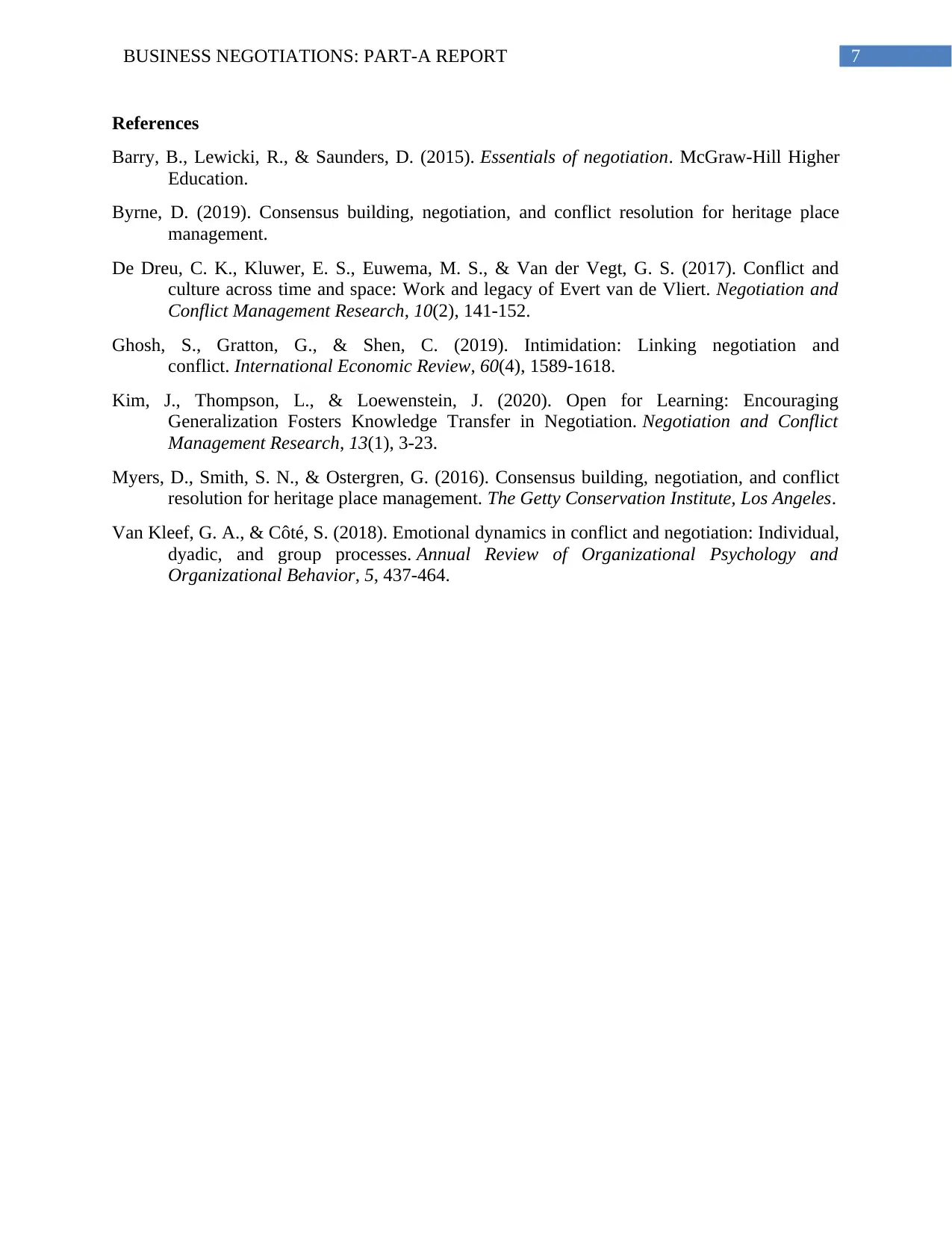
7BUSINESS NEGOTIATIONS: PART-A REPORT
References
Barry, B., Lewicki, R., & Saunders, D. (2015). Essentials of negotiation. McGraw-Hill Higher
Education.
Byrne, D. (2019). Consensus building, negotiation, and conflict resolution for heritage place
management.
De Dreu, C. K., Kluwer, E. S., Euwema, M. S., & Van der Vegt, G. S. (2017). Conflict and
culture across time and space: Work and legacy of Evert van de Vliert. Negotiation and
Conflict Management Research, 10(2), 141-152.
Ghosh, S., Gratton, G., & Shen, C. (2019). Intimidation: Linking negotiation and
conflict. International Economic Review, 60(4), 1589-1618.
Kim, J., Thompson, L., & Loewenstein, J. (2020). Open for Learning: Encouraging
Generalization Fosters Knowledge Transfer in Negotiation. Negotiation and Conflict
Management Research, 13(1), 3-23.
Myers, D., Smith, S. N., & Ostergren, G. (2016). Consensus building, negotiation, and conflict
resolution for heritage place management. The Getty Conservation Institute, Los Angeles.
Van Kleef, G. A., & Côté, S. (2018). Emotional dynamics in conflict and negotiation: Individual,
dyadic, and group processes. Annual Review of Organizational Psychology and
Organizational Behavior, 5, 437-464.
References
Barry, B., Lewicki, R., & Saunders, D. (2015). Essentials of negotiation. McGraw-Hill Higher
Education.
Byrne, D. (2019). Consensus building, negotiation, and conflict resolution for heritage place
management.
De Dreu, C. K., Kluwer, E. S., Euwema, M. S., & Van der Vegt, G. S. (2017). Conflict and
culture across time and space: Work and legacy of Evert van de Vliert. Negotiation and
Conflict Management Research, 10(2), 141-152.
Ghosh, S., Gratton, G., & Shen, C. (2019). Intimidation: Linking negotiation and
conflict. International Economic Review, 60(4), 1589-1618.
Kim, J., Thompson, L., & Loewenstein, J. (2020). Open for Learning: Encouraging
Generalization Fosters Knowledge Transfer in Negotiation. Negotiation and Conflict
Management Research, 13(1), 3-23.
Myers, D., Smith, S. N., & Ostergren, G. (2016). Consensus building, negotiation, and conflict
resolution for heritage place management. The Getty Conservation Institute, Los Angeles.
Van Kleef, G. A., & Côté, S. (2018). Emotional dynamics in conflict and negotiation: Individual,
dyadic, and group processes. Annual Review of Organizational Psychology and
Organizational Behavior, 5, 437-464.
1 out of 8
Related Documents
Your All-in-One AI-Powered Toolkit for Academic Success.
+13062052269
info@desklib.com
Available 24*7 on WhatsApp / Email
![[object Object]](/_next/static/media/star-bottom.7253800d.svg)
Unlock your academic potential
Copyright © 2020–2025 A2Z Services. All Rights Reserved. Developed and managed by ZUCOL.




